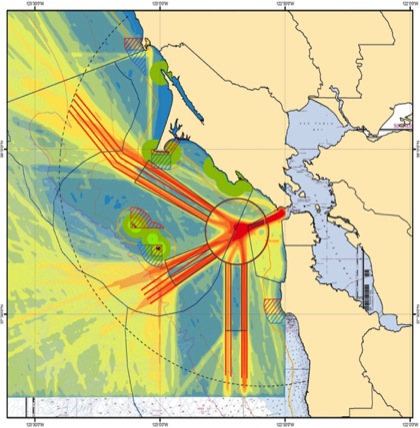
Change is on the land, as well as in the water, for the bay area. Vehicles crossing the Golden Gate Bridge are no longer required to stop for tolls. And now, as of June 1
st, 2013, commercial shipping vessels leaving and entering San Francisco Bay are required to stay in the shipping lanes for an extended distance of approximately 6 miles. But why?
We have abundant marine life along our coastline, including many species of large whales – humpback, gray, fin, sperm, and blue. The whales, and others, are here for the food. Upwelling brings nutrients to the surface, small fish, and even large whales, feed on these nutrients (seaweed and plankton), bigger animals feed on them, and so on up the food web. Because ships and whales co-occur in the same place, there have been incidences of ship strikes. The California Academy of Sciences is part of the
Marine Mammal Stranding Network and responds to these incidents.
However, we want to reduce the issue in the first place! With that as the mission, selected organizations and persons, led by the
Gulf of the Farallones and
Cordell Bank National Marine Sanctuaries vessel strike working group, made several recommendations to reduce the issue of vessel strikes, with whales. The first being extending the shipping lanes. There are three shipping lanes – Northern, Western, and Southern. Observational data shows that whales are feeding in these areas. Thus,
extending the lanes past some of the preferred feeding areas in our waters lessens encounters with whales and ships entering and leaving, the sometimes foggy, San Francisco Bay. Next, the team wants to collect real-time data of whale observations to enable the National Oceanic and Atmospheric Administration (NOAA) to make informed management decisions. Along with aerial observations by the United States Coast Guard, citizen scientists, naturalists, observers, and more can collect and share real-time sightings data. This data can then be utilized to promote dynamic management areas. As an example, if there are a significant number of whales in the northern shipping route, traffic can be diverted to another route.
We appreciate this win for the whales. Stay tuned as data is collected and the dynamic management area is tested for robustness and scalability.
A special thank you to the Cordell Bank National Marine Sanctuary and Gulf of the Farallones National Marine Sanctuary vessel strike and acoustic impacts working group.
